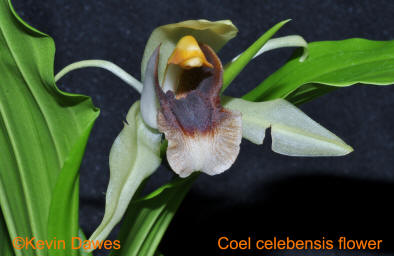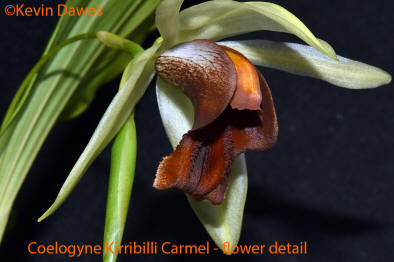Coelogyne Kirribilli Carmel is another new (2016) primary Coelogyne hybrid orchid. A primary hybrid is one made by cross fertilising two species plants. In this case the cross was made with Coelogyne celebensis and Coelogyne usitana - two extremely closely related and interesting orchids.
A major sub-division within Coelogyne orchids is a group called Section SPECIOSAE. This is a very closely related group that contains some of the best known and popular species, such as Coelogyne speciosa. Both these hybrid parents are from this group.
Coelogyne Section SPECIOSAE generally have medium to large flowers that open in succession (one after the other) on very weak flower stems that hang down under the weight of the large flower. One popular theory for this characteristic is that the large flowers act as an umbrella in their very tropical homes to protect the pollen from being washed onto the female organs and causing self pollination. Such an event could limit biodiversity and might not be in the best long term interests of the species.
Coelogyne usitana was only formally described in 2001 and was immediately hailed for its incredibly dark markings on the lip, large flowers and the ability to keep adding one more flower onto its spike for many months - sometimes producing up to 20 flowers on a long trailing flower stem. The plant needs to be grown in a hanging pot to really appreciate the beautiful flowers (or you could visit the Philippines and look up at it growing in tropical forest trees!).
Coelogyne celebensis (from the Bali island of Celebes - now called Sulawesi) has an extremely similar flower but on a much more erect flower spike and generally more erect growth habit. The downside is that it only has 5 - 7 flowers per spike compared to the above partner.
To me, these were obvious candidates for hybridising in an effort to improve the erectness of the flower spikes. The process started with pollination on 13th March 2011. Seeds were flasked on 2.2.2012 and removed from their flasks on 2.4.2013. It flowered for the first time on 14.10.2016 to complete a 5.5 year long process (about normal for Coelogyne hybrids).
Whilst the flower spike of the first seedling was more robust and held the large 9cm flower well above the edge of the pot, it still has the classical downward facing nature of this Coelogyne group.
Because both parents are so closely related there are not obvious visual distinguishing characteristics except for colour. Virtually all of the lip parts, both inside and outside and the column of the hybrid are an extremely rich tobacco colour. The white/whitish tip on the lip of Coelogyne speciosa has almost totally disappeared. .
Negatives: The flower still faces downwards so it should be in a hanging pot. Because both parents come from the tropics, this hybrid will also require good protection from any cold, plenty of warm humidity and dappled shade.
Rating: ♦♦♦♦ This is a beautiful, large flowered Coelogyne. It needs to mature for a couple of years more from the seedling stage before any improvement, if any, in erectness can be properly assessed but I have a suspicion that I am forcing Nature's wisdom in this case.
This hybrid continues my tradition of naming my hybrids after members of my family from our traditional rural farming property, Kirribilli. In this case, it is named after my much younger sister, Carmel, who has close affinities with the natural environment as is evidenced by her beautiful and extensive gardens and a unique collection of rare and unusual trees on her property.
Registration: Registration with the RHS as Coelogyne Kirribilli Carmel was recorded in October 2016.
Varieties: None known.
Hybrids: None registered
| < Coel Kirribilli Anne Dixon | Coel Kirribilli Charlie > |


